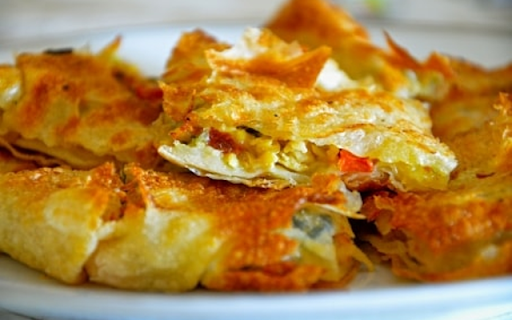How to make Ethiopian food Tibs
 |
| Tibs |
Tibs is a beef dish that is sliced into small
cubes and sautéed in a pan with Niter Kibbeh (clarified butter), vegetables,
herbs, garlic, ginger, and Berbere spice to make a flavorful sauce.
There are several variations in Ethiopia.
Onions, tomatoes, and green peppers are the most regularly utilized vegetables
and herbs. Beef, lamb, venison, and mutton are the most popular meats.
This, like many other Ethiopian meals, is
served with Injera, a traditional Ethiopian sourdough pancake made with teff
flour. It is traditionally eaten with the fingers by dipping a piece of Injera into the dish and using the bread as a spoon to gather a piece of meat and
sauce.
Tibs was traditionally provided to pay someone
a compliment or demonstrate respect. It's still considered a special meal
today, which explains its appeal as a way to commemorate important occasions
and holidays. On the other hand, if you stroll into a loud pub in Ethiopia's
raucous capital, Addis Ababa, on a Friday afternoon, it's probable that the
majority of the patrons will be ordering and eating tibs.
Ingredients needed to make Tibs:
- Meat (beef) chopped into small cubes
- A bit of oil
- A half spoon minced garlic
- One spoon of Berbere (Ethiopian spicy ingredient)
- One sliced onion
- One sliced tomato
- Salt (as per your need)
- Niter Kibbeh (clarified butter)
- One fresh sliced green chili
Steps
Step 1: Start by chopping the meat into small cubes.
Step 2: Then turn on the stove and add the
meat (beef) into the pot. Cook the meat at a high temperature and once the color
is changed add it to a bowl.
Step 3: On the same pot (you don't have to
wash it), add a bit of oil and a half spoon of minced garlic and stir. Wait for a minute
till the garlic is cooked.
Step 4: Add the meat from the bowl back to the
pot. And mix them all.
Step 5: Add one spoon of Berbere (Ethiopian
spicy ingredient) and mix well.
Step 6: Lower the heat level and add one
sliced onion and mix.
Step 7: Add one sliced tomato and mix again.
Step 8: Next, add salt (as per your need) and Niter
Kibbeh (clarified butter) and mix.
Step 9: Add one fresh sliced green chili and
mix slowly.
Step 10: Congratulations you have made your
first Tibs. You can now turn off the stove and start serving.
Source
How do you serve Tibs?
Tibs can be eaten with cooked green vegetables
and a thick bread called "kocho" (outside of Ethiopia,
"Injera" bread is more common because it is simpler to come by). You
eat a slice of meat with some cheese on a piece of bread. The cheese helps to
cool down the chili's spiciness.
What is Berbere (Ethiopian spicy ingredient)?
Berbere is a spice blend made out of chili
peppers, coriander, garlic, ginger, Ethiopian holy basil (besobela) seeds,
korarima, rue, ajwain or radhuni, nigella, and fenugreek. It's an important
element in Ethiopian and Eritrean cuisines.
Berbere can also refer to plants and spices
that aren't well-known outside of Africa. Korarima (Aframomum corrorima) and
long pepper, for example, are both cultivated and wild plants that thrive in
Ethiopia.
What can I use instead of Berbere?
As a replacement, cayenne pepper is sometimes
employed. It's commonly seen in stews and soups. If you can't find it at local
grocery shop or specialized store, it's fairly simple to manufacture your own.
What does Berbere taste like?
Berbere is a spicy chili combination with a
rich taste that isn't overly hot. Berbere is mellowed by sweet, lemony notes,
while it isn't precisely light. Berbere has no uniform flavor characteristic
since it comprises several components, each with its own distinct flavor and
scent.
What is Niter Kibbeh?
Niter kibbeh, or niter qibe, is a seasoned,
clarified butter used in Ethiopian and Eritrean cuisine. It is also known as
tesmi (in Tigrinya). It's made in the same way as ghee, but before filtering,
it's boiled with spices such besobela (Ethiopian sacred basil), koseret,
fenugreek, cumin, coriander, turmeric, Ethiopian cardamom (korarima), cinnamon,
or nutmeg, giving it a unique, spicy scent. Yeqimem zeyet is the variant that
uses vegetable oil instead of butter.
What can I substitute for Niter kibbeh?
Niter kibbeh (spice-infused clarified butter)
is a common cooking medium in Ethiopian cuisine that gives meals an unrivaled
taste. If you don't have time to produce niter kibbeh, you may replace plain
butter or oil in Ethiopian dishes, but something unique will be lacking.
What makes Ethiopian cousins special?
Did you realize that Ethiopian cuisine has
long included vegetarian dishes? Ethiopian cooking culture has long used a
variety of rich and colorful vegetables, fruits, beans, and pulses as the main
components in many of their exquisite vegan-friendly recipes. Veganism has been
fashionable in the West in recent years, but Ethiopians have long enjoyed vegan
foods and the health benefits of a plant-based diet.
Ethiopians aren't afraid to use a lot of
spices. Berbere, an Ethiopian spice blend including up to 16 constituent parts
such as chili powder, fenugreek, ginger, garlic, cardamom, and cinnamon, is one
of the most popular accompaniments.
Another advantage of eating Ethiopian food is
that injera is made from teff, the world's tiniest grain, which Ethiopians have
grown for millennia and are obsessed with. It is increasingly being referred to
as a "super grain" in the United States and Europe, alongside quinoa
and spelt, because it is high in protein and calcium and gluten-free.
All of the above will make your taste buds
perform somersaults while also being beneficial to your health. The majority of
Ethiopian recipes are high in nutrients and low in fat.












0 Comments